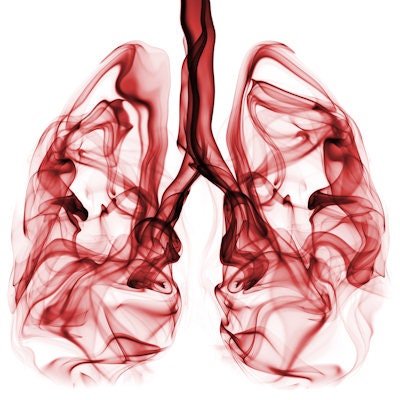
Low-dose CT lung cancer screening may be reimbursed by insurance now, but you'd hardly know it by the low numbers of high-risk smokers taking advantage of it, according to a February 2 research letter in JAMA Oncology.
In their study, researchers from the American Cancer Society's Surveillance and Health Services Research team in Atlanta examined results from more than 2,000 respondents to the National Health Interview Survey (NHIS) in 2015. They compared these results with responses to the same survey acquired in 2010.
Only 2% to 4% of eligible smokers underwent low-dose CT (LDCT) in 2010, and the numbers were virtually unchanged in 2015. The results were consistent across socioeconomic groups, and most primary care physicians were still unaware that Medicaid paid for CT lung cancer screening, the study team reported.
"We estimated that by 2015 there would be 6.8 million smokers eligible for screening, but only 262,000 were screened," said lead author Ahmedin Jemal, PhD, in an interview with AuntMinnie.com. "It's a very complicated situation. I think there's a knowledge gap among physicians and also among patients, in addition to an access problem."
Preventable deaths
Lung cancer kills nearly 160,000 Americans per year, and most patients still present with symptoms when their cancers are already too advanced for curative resection.
Following results from the 2011 National Lung Screening Trial (NLST), which showed that lung cancer screening with CT could reduce lung cancer deaths by at least 20%, the U.S. Preventive Services Task Force (USPSTF) in 2013 recommended annual low-dose CT screening among high-risk smokers with a minimum smoking history of 30 pack-years, or former smokers who have quit within the past 15 years.
The 2010 National Health Interview Survey found that just 2% to 4% of high-risk smokers received low-dose CT in the previous year. The question was, would screening rates increase after it became more widely available and covered by Medicare?
"In this study, we examined whether LDCT screening has increased following the USPSTF recommendation," wrote Jemal and Stacey Fedewa, PhD (JAMA Oncology, February 2, 2017).
Jemal and Fedewa compared data from the 2010 and 2015 surveys, which included 2,347 participants who met the USPSTF criteria for low-dose CT lung cancer screening. The primary outcome for the study was the number of eligible screening subjects who self-reported having been screened in the previous year. The analyses excluded respondents with unknown (n = 6) or a self-reported history of lung cancer (n = 41), as well as individuals who were missing low-dose CT test information (n = 133), leaving 2,167 adults.
Using a publicly available database in which patients had been deidentified, the authors calculated the weighted prevalence of LDCT for lung cancer screening in the past year.
Low participation
From 2010 to 2015, the percentage of eligible smokers undergoing screening barely moved, rising from 3.3% in 2010 to 3.9% in 2015 (p = 0.060). Of the 6.8 million smokers eligible for screening in 2015, only 262,700 were screened. And the results were consistent across sociodemographic lines and subgroups, except between patients with or without a history of bronchitis.
"The increase was not significant," Jemal said. "One important thing is, of all the smokers who had a recommendation for CT screening, 50% were uninsured or Medicaid-insured, and these patients are also likely to have low educational attainment."
There may also be a broad lack of knowledge about low-dose CT, as well as a lack of access to care and gaps in physicians' knowledge about screening and reimbursement. For example, a 2015 survey of physicians in South Carolina found that only 36% knew that screening should be conducted annually in high-risk individuals, and 63% were unaware that Medicare covers CT screening for high-risk individuals, the authors noted.
Even if physicians are aware of CT lung screening, they may have limited access to high-volume, high-quality radiology centers, a recommendation set forth by public health organizations and a stipulation of Medicare reimbursement, Jemal said.
There was also a decline in the number of screening-eligible smokers, from 8.4 million in 2010 to 6.8 million in 2015, reflecting progress in tobacco control -- a statistic with positive implications for lung cancer screening, Jemal and Fedewa noted. Study limitations include the potential of recall bias, as well as the limited amount of time that has passed since the USPSTF lung cancer screening recommendation and the positive decision on reimbursement by the U.S. Centers for Medicare and Medicaid Services (CMS).
The study offers the first national estimate of low-dose CT screening following the USPSTF recommendation, the authors wrote.
Screening uptake remains low among both current and former heavy smokers and is unchanged statistically since the USPSTF recommended screening. The low uptake signals a need to educate clinicians as well as smokers about the benefits and risks of lung cancer screening for informed decision-making, they wrote.
"Screening requires a lot of things: First you have to educate the physicians and the patients, and half of your patients aren't covered by Medicare," Jemal said. "You have to have high-capacity screening centers -- how many of these do we have and where are they? If we don't have capacity, we're not going to expand CT screening. And we have to train more radiologists. We have to be ready."




















